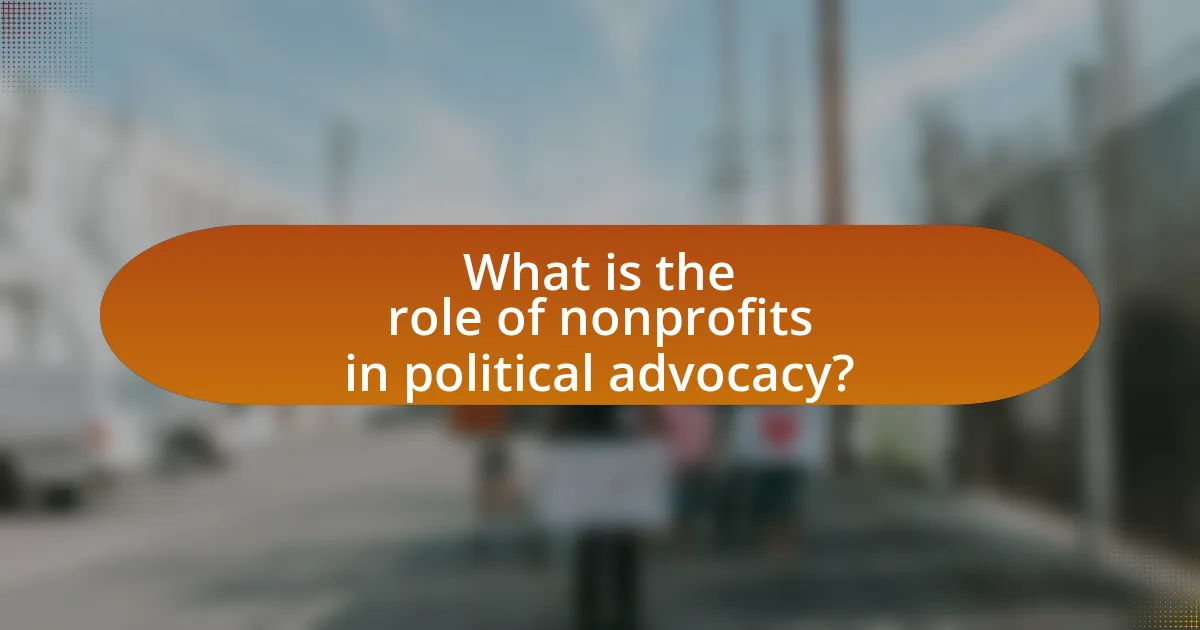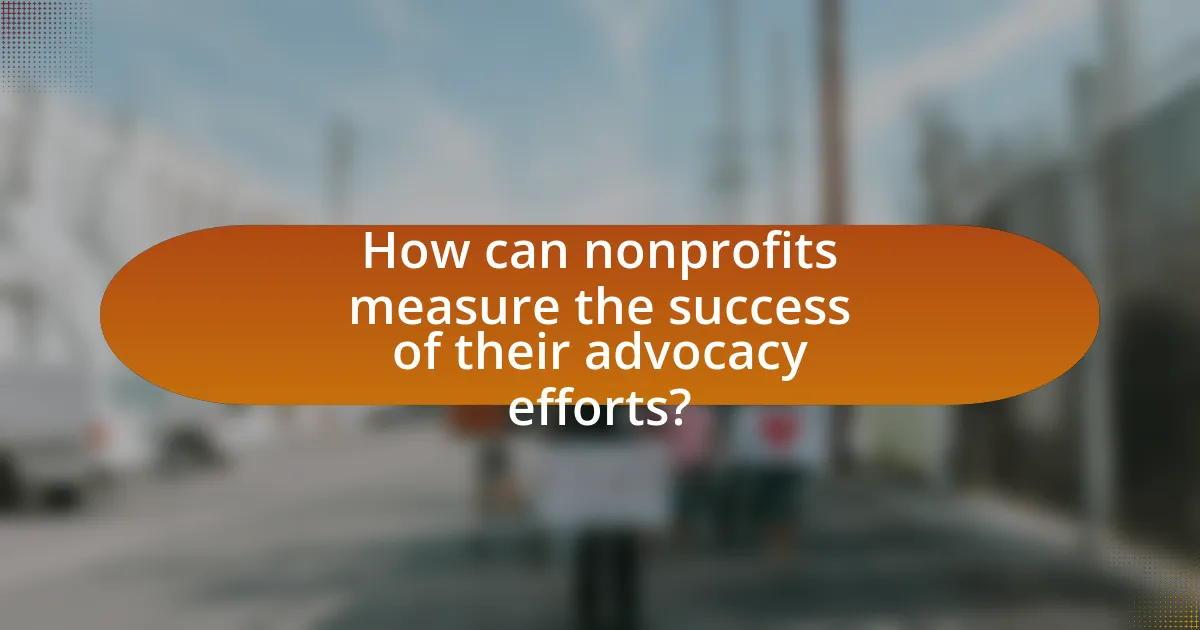Nonprofits play a vital role in political advocacy by representing diverse interests and mobilizing public support for social change. They engage in lobbying, public education, and policy influence to ensure underrepresented voices are heard, thereby enhancing civic engagement and accountability. The article outlines how nonprofits influence political decision-making through advocacy strategies, coalition building, and grassroots mobilization, while also addressing the importance of compliance with legal regulations. Additionally, it discusses best practices for effective advocacy, including clear communication, data-driven strategies, and community engagement, as well as the challenges nonprofits face in navigating political landscapes.

What is the role of nonprofits in political advocacy?
Nonprofits play a crucial role in political advocacy by representing diverse interests and mobilizing public support for social change. They engage in activities such as lobbying, educating the public, and influencing policy decisions to promote their missions. For instance, according to the National Council of Nonprofits, nonprofits contribute to democracy by ensuring that underrepresented voices are heard in the political process, thereby enhancing civic engagement and accountability. Additionally, research from the Urban Institute indicates that nonprofits often serve as intermediaries between the government and the community, facilitating dialogue and collaboration on critical issues.
How do nonprofits influence political decision-making?
Nonprofits influence political decision-making primarily through advocacy, lobbying, and public engagement. By mobilizing constituents and raising awareness on specific issues, nonprofits can shape public opinion and pressure policymakers to consider their perspectives. For instance, organizations like the American Civil Liberties Union (ACLU) have successfully influenced legislation by leveraging legal challenges and public campaigns to highlight civil rights issues, resulting in significant policy changes. Additionally, nonprofits often provide research and data that inform policymakers, thereby enhancing the quality of decision-making. Their ability to connect with grassroots movements further amplifies their impact, as seen in campaigns like the Sierra Club’s efforts to promote environmental legislation, which have led to the enactment of key environmental protections.
What strategies do nonprofits use to engage in advocacy?
Nonprofits engage in advocacy through strategies such as grassroots mobilization, coalition building, and policy research. Grassroots mobilization involves rallying community members to participate in campaigns, which can increase public awareness and pressure policymakers. Coalition building allows nonprofits to unite with other organizations to amplify their voices and resources, enhancing their influence on legislative issues. Policy research provides evidence-based data that supports advocacy efforts, enabling nonprofits to present compelling arguments to stakeholders. For instance, the National Council of Nonprofits highlights that effective advocacy often relies on a combination of these strategies to create a comprehensive approach that can lead to meaningful policy change.
How do nonprofits build coalitions for political influence?
Nonprofits build coalitions for political influence by strategically aligning with other organizations that share similar goals and values. This collaboration enhances their collective voice and increases their capacity to advocate for policy changes. For instance, nonprofits often engage in joint campaigns, share resources, and coordinate messaging to amplify their impact. Research indicates that coalitions can lead to more effective lobbying efforts, as seen in the 2017 coalition of environmental nonprofits that successfully influenced climate policy by uniting diverse stakeholders. By pooling expertise and mobilizing grassroots support, nonprofits can create a formidable presence in the political landscape.
Why is political advocacy important for nonprofits?
Political advocacy is important for nonprofits because it enables them to influence public policy and drive social change. By engaging in advocacy, nonprofits can represent the interests of their constituents, raise awareness about critical issues, and mobilize resources to address societal challenges. For instance, according to a report by the National Council of Nonprofits, nonprofits that engage in advocacy can effectively shape legislation that impacts their missions, such as healthcare reform or environmental protection. This capacity to advocate not only amplifies their voice but also enhances their ability to secure funding and support for their initiatives, ultimately leading to greater community impact.
What impact does advocacy have on nonprofit missions?
Advocacy significantly enhances nonprofit missions by amplifying their voice and influence in policy-making processes. Nonprofits that engage in advocacy can effectively raise awareness about their causes, mobilize community support, and drive systemic change. For instance, a study by the National Council of Nonprofits indicates that advocacy efforts can lead to increased funding and resources, as policymakers are more likely to support initiatives that have strong public backing. This demonstrates that advocacy not only aligns with but also propels the core objectives of nonprofit organizations, ultimately leading to greater impact and sustainability in their missions.
How can advocacy enhance community engagement for nonprofits?
Advocacy enhances community engagement for nonprofits by mobilizing individuals around shared causes and fostering a sense of collective action. When nonprofits engage in advocacy, they create platforms for community members to voice their concerns and participate in decision-making processes, which increases awareness and investment in local issues. For instance, a study by the National Council of Nonprofits found that organizations involved in advocacy reported higher levels of community participation and support, demonstrating that advocacy efforts can lead to increased volunteerism and donations. This active involvement not only strengthens the nonprofit’s mission but also builds a more informed and engaged community.

What are the best practices for nonprofits in political advocacy?
The best practices for nonprofits in political advocacy include establishing clear goals, building coalitions, engaging in grassroots mobilization, and ensuring compliance with legal regulations. Establishing clear goals allows nonprofits to focus their efforts on specific issues, making their advocacy more effective. Building coalitions with other organizations enhances influence and resource sharing, as seen in successful campaigns like the 2017 Women’s March, which united various groups for a common cause. Engaging in grassroots mobilization empowers community members to participate actively, increasing the visibility and impact of advocacy efforts. Lastly, ensuring compliance with legal regulations, such as the IRS guidelines on lobbying, protects nonprofits from potential legal repercussions and maintains their tax-exempt status. These practices collectively enhance the effectiveness and sustainability of nonprofit advocacy efforts.
How can nonprofits effectively communicate their advocacy goals?
Nonprofits can effectively communicate their advocacy goals by utilizing clear messaging, engaging storytelling, and targeted outreach strategies. Clear messaging ensures that the core objectives are easily understood by the audience, while engaging storytelling helps to connect emotionally with stakeholders, making the issues more relatable. Targeted outreach strategies, such as social media campaigns and community events, allow nonprofits to reach specific demographics and mobilize support. According to a study by the Nonprofit Marketing Guide, 70% of nonprofits that use storytelling report increased engagement from their audience, demonstrating the effectiveness of these communication methods.
What messaging strategies resonate with policymakers?
Messaging strategies that resonate with policymakers include data-driven narratives, clear and concise communication, and alignment with policymakers’ priorities. Data-driven narratives leverage statistics and research to substantiate claims, making the message more credible and persuasive. For instance, a study by the Pew Research Center found that 70% of policymakers prefer information backed by solid data, which enhances the likelihood of engagement. Clear and concise communication ensures that messages are easily digestible, allowing busy policymakers to grasp key points quickly. Additionally, aligning messages with the specific priorities and agendas of policymakers increases relevance, as evidenced by a report from the National Council of Nonprofits, which states that tailored messaging significantly improves the chances of policy adoption.
How can nonprofits utilize social media for advocacy?
Nonprofits can utilize social media for advocacy by creating engaging content that raises awareness about their causes and mobilizes supporters. By leveraging platforms like Facebook, Twitter, and Instagram, nonprofits can share impactful stories, infographics, and videos that resonate with their audience, thereby increasing visibility and engagement. Research indicates that 70% of social media users are more likely to support a cause after seeing it on social media, highlighting the effectiveness of these platforms in driving advocacy efforts. Additionally, nonprofits can use targeted ads to reach specific demographics, facilitating more focused advocacy campaigns.
What legal considerations should nonprofits be aware of in advocacy?
Nonprofits must be aware of several legal considerations in advocacy, primarily focusing on compliance with federal and state laws governing lobbying and political activities. The Internal Revenue Service (IRS) regulates the extent to which nonprofits can engage in lobbying, stipulating that 501(c)(3) organizations can participate in limited lobbying activities as long as it does not constitute a substantial part of their overall activities. Additionally, nonprofits must adhere to the Federal Election Commission (FEC) regulations, which prohibit them from engaging in partisan political activities. Violating these regulations can result in loss of tax-exempt status or legal penalties. Therefore, understanding the definitions of lobbying versus advocacy, maintaining accurate records of lobbying expenditures, and ensuring that any political activities align with their mission are crucial for nonprofits to navigate the legal landscape effectively.
What are the restrictions on lobbying for nonprofits?
Nonprofits face specific restrictions on lobbying, primarily governed by IRS regulations. Under Section 501(c)(3) of the Internal Revenue Code, these organizations are prohibited from engaging in substantial lobbying activities, which is defined as more than an insubstantial part of their overall activities. This means that while nonprofits can advocate for issues and influence legislation, they must ensure that their lobbying efforts do not exceed a certain threshold, typically measured by time or financial resources. Additionally, nonprofits must report their lobbying expenditures and activities to maintain compliance with federal regulations.
How can nonprofits ensure compliance with campaign finance laws?
Nonprofits can ensure compliance with campaign finance laws by implementing robust financial tracking systems and maintaining transparency in their political activities. These organizations must familiarize themselves with federal and state regulations governing campaign contributions and expenditures, as outlined by the Federal Election Commission (FEC) and relevant state authorities. Regular training for staff on compliance requirements and the establishment of clear policies for political engagement are essential steps. Additionally, nonprofits should conduct periodic audits to verify adherence to these laws, thereby minimizing the risk of violations and ensuring accountability in their advocacy efforts.

How can nonprofits measure the success of their advocacy efforts?
Nonprofits can measure the success of their advocacy efforts through specific metrics such as policy changes, increased public awareness, and engagement levels. For instance, tracking the number of legislative bills influenced or passed as a result of advocacy campaigns provides concrete evidence of impact. Additionally, conducting surveys to assess shifts in public opinion or awareness related to the nonprofit’s cause can quantify success. Engagement metrics, such as social media interactions or attendance at advocacy events, also serve as indicators of effectiveness. Research shows that organizations that utilize these metrics can better understand their influence and adapt strategies accordingly, enhancing their overall advocacy effectiveness.
What metrics can be used to evaluate advocacy impact?
Metrics used to evaluate advocacy impact include policy changes, public awareness levels, stakeholder engagement, and funding increases. Policy changes can be measured by tracking legislation or regulations influenced by advocacy efforts, demonstrating direct outcomes. Public awareness levels can be assessed through surveys or media coverage analysis, indicating shifts in public opinion or knowledge. Stakeholder engagement metrics, such as the number of partnerships formed or participation in advocacy events, reflect the mobilization of support. Funding increases can be quantified by comparing financial contributions before and after advocacy campaigns, showcasing the effectiveness of outreach efforts. These metrics provide concrete evidence of advocacy impact and effectiveness in achieving organizational goals.
How can nonprofits track changes in policy as a result of their advocacy?
Nonprofits can track changes in policy resulting from their advocacy by implementing systematic monitoring and evaluation strategies. These strategies include establishing clear objectives for advocacy efforts, utilizing policy tracking tools, and engaging in regular communication with policymakers to assess the impact of their initiatives. For instance, organizations can use platforms like LegiScan or GovTrack to monitor legislative changes and analyze how specific advocacy campaigns influence policy outcomes. Additionally, collecting data on policy changes, such as new laws or amendments, and correlating them with advocacy activities provides concrete evidence of effectiveness. This approach is supported by research from the Center for Nonprofit Advancement, which highlights the importance of data-driven evaluation in demonstrating advocacy impact.
What role does feedback play in refining advocacy strategies?
Feedback is crucial in refining advocacy strategies as it provides insights into the effectiveness of current approaches and identifies areas for improvement. By systematically gathering feedback from stakeholders, including community members and policymakers, nonprofits can assess the impact of their advocacy efforts and adjust their strategies accordingly. For instance, a study by the Stanford Social Innovation Review highlights that organizations that actively solicit and incorporate feedback are more likely to achieve their advocacy goals, as they can better align their messaging and tactics with the needs and perspectives of their target audience. This iterative process of feedback and adjustment enhances the overall effectiveness of advocacy initiatives.
What are some common challenges nonprofits face in political advocacy?
Nonprofits face several common challenges in political advocacy, including limited funding, regulatory restrictions, and competition for attention. Limited funding restricts their ability to mobilize resources effectively, as many nonprofits rely on donations and grants that may not cover advocacy efforts. Regulatory restrictions, such as the Johnson Amendment in the U.S., limit the political activities of nonprofits, making it difficult for them to engage fully in advocacy without risking their tax-exempt status. Additionally, competition for attention from larger organizations or well-funded political campaigns can overshadow the voices of smaller nonprofits, making it challenging for them to influence policy effectively. These challenges hinder the overall impact of nonprofit advocacy efforts in the political landscape.
How can nonprofits overcome resource limitations in advocacy?
Nonprofits can overcome resource limitations in advocacy by leveraging partnerships and collaborations with other organizations. By forming coalitions, nonprofits can pool resources, share expertise, and amplify their collective voice, which enhances their advocacy efforts. For example, the National Council of Nonprofits highlights that collaborative advocacy can lead to more significant impact, as seen in successful campaigns where multiple organizations united to address common issues, thereby maximizing their reach and effectiveness. Additionally, utilizing digital tools and social media allows nonprofits to engage a broader audience at a lower cost, further mitigating resource constraints.
What strategies can help nonprofits navigate political opposition?
Nonprofits can navigate political opposition by employing strategies such as building coalitions, engaging in grassroots mobilization, and utilizing effective communication. Building coalitions with other organizations enhances influence and resources, as seen in the successful collaboration of environmental groups during the 2016 Paris Agreement negotiations. Grassroots mobilization empowers community members to advocate for their causes, exemplified by the Women’s March in 2017, which demonstrated significant public support for women’s rights. Effective communication, including clear messaging and storytelling, helps nonprofits articulate their mission and counter opposition narratives, as evidenced by the success of organizations like the Human Rights Campaign in advancing LGBTQ+ rights through compelling campaigns.
What practical tips can nonprofits implement for effective advocacy?
Nonprofits can implement several practical tips for effective advocacy, including building strong coalitions, utilizing data-driven strategies, and engaging in grassroots mobilization. Strong coalitions enhance influence by pooling resources and amplifying voices, as seen in successful campaigns like the Coalition for Immigrant Rights, which united various organizations to advocate for policy changes. Data-driven strategies involve collecting and analyzing relevant statistics to support advocacy efforts, such as using demographic data to highlight community needs, which can lead to more persuasive arguments. Grassroots mobilization encourages community involvement, exemplified by the success of organizations like MoveOn, which effectively mobilized supporters through social media campaigns to influence public policy. These strategies collectively enhance the effectiveness of nonprofit advocacy efforts.


